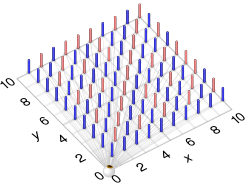Euclid's orchard
In mathematics, informally speaking, Euclid's orchard is an array of one-dimensional "trees" of unit height planted at the lattice points in one quadrant of a square lattice.[1] More formally, Euclid's orchard is the set of line segments from (x, y, 0) to (x, y, 1), where x and y are positive integers.
The trees visible from the origin are those at lattice points (x, y, 0), where x and y are coprime, i.e., where the fraction x/y is in reduced form. The name Euclid's orchard is derived from the Euclidean algorithm.
If the orchard is projected relative to the origin onto the plane x + y = 1 (or, equivalently, drawn in perspective from a viewpoint at the origin) the tops of the trees form a graph of Thomae's function. The point (x, y, 1) projects to
- [math]\displaystyle{ \left ( \frac {x}{x+y}, \frac {y}{x+y}, \frac {1}{x+y} \right ). }[/math]
The solution to the Basel problem can be used to show that the proportion of points in the [math]\displaystyle{ n\times n }[/math] grid that have trees on them is approximately [math]\displaystyle{ \tfrac{6}{\pi^2} }[/math] and that the error of this approximation goes to zero in the limit as n goes to infinity.[2]
See also
References
- ↑ Weisstein, Eric W.. "Euclid's Orchard". http://mathworld.wolfram.com/EuclidsOrchard.html.
- ↑ Vandervelde, Sam (2009). "Chapter 9: Sneaky segments". Circle in a Box. MSRI Mathematical Circles Library. Mathematical Sciences Research Institute and American Mathematical Society. pp. 101–106.
External links
- Euclid's Orchard, Grade 9-11 activities and problem sheet, Texas Instruments Inc.
- Project Euler related problem
 |




